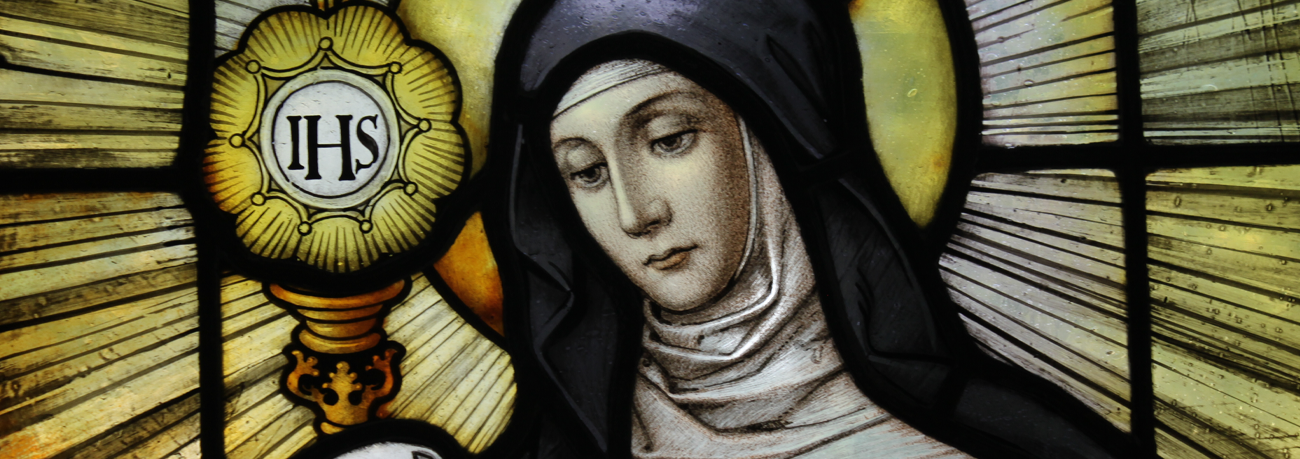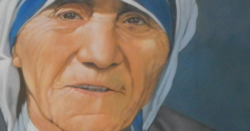Name that Saint: Clare
Indebted to a Courageous Woman
 In 1194, Chiara Offreduccio was born to the wealthy, noble family of Ortolana and Favorino Sciffi. Chiara’s status required her to read and write, embroider, and spin yarn. Yet, as a young girl, she spent time in prayer and hid portions of her food to give to the poor.
In 1194, Chiara Offreduccio was born to the wealthy, noble family of Ortolana and Favorino Sciffi. Chiara’s status required her to read and write, embroider, and spin yarn. Yet, as a young girl, she spent time in prayer and hid portions of her food to give to the poor.
At 17, Chiara (also known as Clare) heard St. Francis of Assisi preach. His words inspired her, so she asked him to help her live the radical Gospel poverty he was living. Unfortunately, her family had already planned her marriage, so Clare secretly left her home late at night on Palm Sunday of 1212. But she didn’t merely sneak out the door while her family was sleeping; she quietly escaped through the “death door,” which was a symbolic gesture. “Death doors” were built in houses to remove the bodies of deceased family members after their wakes were held, since it was considered bad luck to carry a casket through the home’s main entrance.
Clare met St. Francis and his friars at the city gate, and walked with them to the Porciuncula, the church of Mary, Our Lady of the Angels. There, she devoted her life to Jesus under St. Francis’s guidance. Renouncing worldly pleasures, Clare replaced her wealthy clothing with the same course habit the brothers wore. St. Francis then cut her hair and placed a veil on her head to signify her complete consecration to God.
As the first female follower of St. Francis, there was no place for Clare to live, so he made arrangements for her to stay in a Benedictine monastery until a convent was built. After her consecration, the Franciscans walked Clare to the monastery where the sisters were waiting for her. As soon as her father discovered what happened, he went to the monastery and tried to force her back home. Clare ran into the chapel and adamantly clung to the altar. She wasn’t leaving.
Because she desired greater solitude, St. Francis arranged for her to move to another Benedictine monastery farther away. Soon, her sister Catarina joined her and when the small house next to the church of San Damiano was finished, they moved into what became the first convent of the Order. Years later, her mother, another sister, and an aunt joined her community.
Their life was simple and poor, filled with manual labor, prayer, and silence. They owned no property, wore no shoes, ate no meat, slept on beds made from twigs, and rarely spoke, maintaining silence throughout the day and night. In the thirteenth century, this was beyond extreme; no other religious order had embraced poverty so radically.
Several religious authorities questioned if the women could survive without some form of material possessions. On many occasions, Clare was given the opportunity to relax their strict vow of poverty. However, she steadfastly refused. To ensure her community would not be forced to accept property, she asked the pope for the privilege of living in austere poverty. He willingly agreed.
Even though the sisters were undoubtedly poor, they were filled with joy, and young women began joining them, some traveling from other parts of Europe. They were called “the Poor Ladies of San Damiano,” and for a short period of time St. Francis directed the new community. In 1215, Clare reluctantly accepted the title of abbess. Like the friars, they did not initially have a Rule of Life but followed a formula vitae, a guideline to practice the counsels of the Gospel.
In 1219, while St. Francis was in the Holy Land, a Rule of Life based on the Benedictine Rule was written for the sisters. It was austere but omitted the privilege of absolute poverty; instead, it allowed for the possession of common property. Clare protested, and the community continued living in their accustomed poverty.
After St. Francis died in 1226, Clare wanted to ensure their life of poverty was integrated in the Rule. So she took the Rule of 1219, conformed it to the Rule St. Francis wrote for the Friars Minor, and petitioned Rome to accept the new Rule for her Order.
Finally in 1228, Pope Gregory IX issued a formal decree granting Clare’s request for the Privilege of Poverty, which protected their Franciscan spirit of poverty. This was the first and last time a privilege of this kind was granted.
Clare’s profound love for Christ led her to a deeper love for Jesus in the Blessed Sacrament. On two occasions, as invading armies approached the monastery to attack it, Clare carried the Blessed Sacrament to the walls where the enemies could see it. There, she knelt and prayed for protection. In both instances, the attackers retreated.
In 1253, days before her death, Pope Innocent IV officially confirmed her Rule of Life for the Order of Poor Ladies. This was the first Rule of Life written by a woman that received papal approval. Two days later, at the age of 59, Clare died. Her last words were, “Blessed be You, O God, for having created me.”
She was canonized on the Feast of the Assumption two years after her death. Ten years later, Pope Urban IV officially changed the name of the Order of Poor Ladies to the Order of St. Clare (commonly called the Poor Clares).
In his general audience on September 15, 2010, Pope-Emeritus Benedict said of St. Clare, “Her testimony shows us how indebted the Church is to courageous women, full of faith like her, who can give a crucial impetus to the Church’s renewal. … Those who change the world for the better are holy, they transform it permanently, instilling in it the energies that only love inspired by the Gospel can elicit. The Saints are humanity’s great benefactors!”
St. Clare’s Feast Day is August 11. She is the patron saint of eye disease, goldsmiths, laundry, television, bicycle messengers, good weather, and needle workers.
“May you cling to His most sweet Mother, who gave birth to the kind of Son whom the Heavens could not contain, and yet, she carried Him in the tiny enclosure of her sacred womb, and held Him on her young girl’s lap.” ~ St. Clare of Assisi
Get InSPIREd!
Sign up below and receive our monthly inspirational Newsletter dedicated to Mary!



